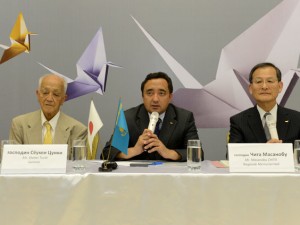 ASTANA – The “Memories of Hiroshima and Nagasaki” exhibition, which depicts the devastation of those atomic bombings and is dedicated to 23rd anniversary of the closure of the Semipalatinsk nuclear test site in eastern Kazakhstan, opened here on Aug. 6.
ASTANA – The “Memories of Hiroshima and Nagasaki” exhibition, which depicts the devastation of those atomic bombings and is dedicated to 23rd anniversary of the closure of the Semipalatinsk nuclear test site in eastern Kazakhstan, opened here on Aug. 6.
“It is a great honour for us to hold the exhibition in Kazakhstan, because the residents of your country are familiar with the tragedy that was experienced by Japan. During the Soviet times, the nuclear test site was operating in the country. It is the common fate of our peoples. This must never be forgotten,” said Masanobu Chita, director of the Nagasaki National Peace Memorial Complex, which organised the exhibition at the Palace of Independence with the support of the Ministry of Foreign Affairs of Kazakhstan, the Kazakhstan-Japan Centre for Human Resources Development and the Astana akimat (city administration).
“Aug. 6, 1945 entered into human history as a day of tragedy for the Japanese people, affected by the atomic bombings of Hiroshima and [later] Nagasaki,” said Barlybai Sadykov, Ambassador-at-Large of the Ministry of Foreign Affairs of Kazakhstan, in his welcoming speech. “For nearly 70 years, this day has been marked as a day of remembrance and mourning. For the people of Kazakhstan, who experienced tragedy of nuclear testing, the pain and suffering of the people of Japan are deeply understood. At the Semipalatinsk test site during the 40 years of its existence, from 1949 to 1989, over 450 nuclear explosions took place, affecting over a million people.”
Sadykov also spoke about the ATOM Project, an international education campaign launched by Kazakhstan to galvanise global public opinion about the need to rid the world of nuclear weapons testing and, ultimately, the nuclear weapons. Under this project, which tells the stories of nuclear weapons testing survivors, every person, who is against nuclear tests, can sign the online petition to the governments of the world calling for abolishing nuclear tests forever.
The Nagasaki Peace Memorial Complex has held expositions annually since 2005 around the world to inform the public about the dangers of nuclear weapons and the need to maintain peace in the world.
“I witnessed the tragedy in the dormitory. We tried to escape with my group-mates. I am the only one who is still alive today. Others died of the consequences of the nuclear catastrophe,” said Souhei Tsuiki, eyewitness of the bombing in Nagasaki, during the launch ceremony for the exhibition.
Tsuiki was 18 years old when the atomic bombing in Nagasaki occurred. He was sleeping in the dormitory of Nagasaki Pedagogical College, which was located 18 kilometres from the epicentre. Students of the college were mobilised for work in the Mitsubishi military plant in Akasako.
The exhibition includes large photographs depicting the tragedy of the bombings and their consequences, eyewitness statements, documentaries about the bombings, survivors’ diaries and paper cranes popular in Nagasaki and Hiroshima as a symbol of a prayer for peace.Visitors can also leave messages, which will be delivered to Nagasaki for storage in the Peace Memorial Complex.
Kazakhstan is the tenth country where the “Memories of Hiroshima and Nagasaki” exhibition has been held. The United States was the first and, according to Tsuiki, many Americans cried and asked for forgiveness when they heard his story.
The exhibition will remain open to the public in Astana until Aug. 25 before it travels to Semey, where it will be displayed until Sept. 3 in Semey’s historical museum. The exhibition will then be displayed in Almaty from Sept. 10 until the end of the month.
The Nagasaki Peace Memorial Complex is a National Institute of Japan dedicated to the victims of the atomic bombing of Nagasaki, which took place on Aug. 9, 1945. The memorial complex was built as a place of remembrance and prayer for those who died in the explosion of the atomic bomb. Photographs, memories and personal items related to the bombing are stored there.
